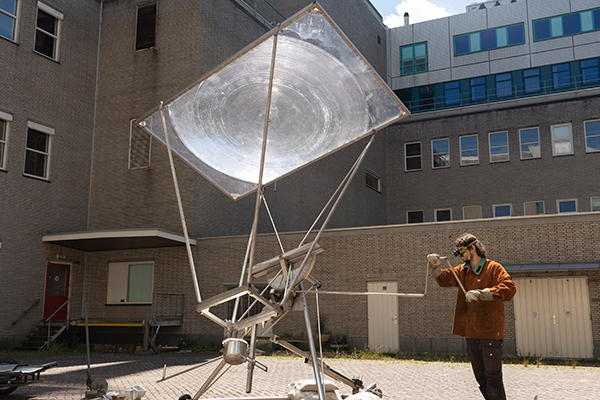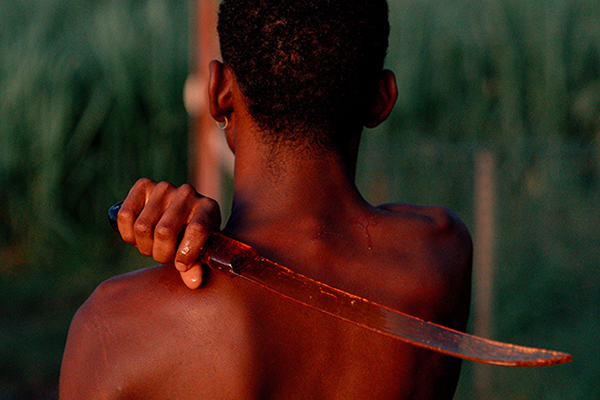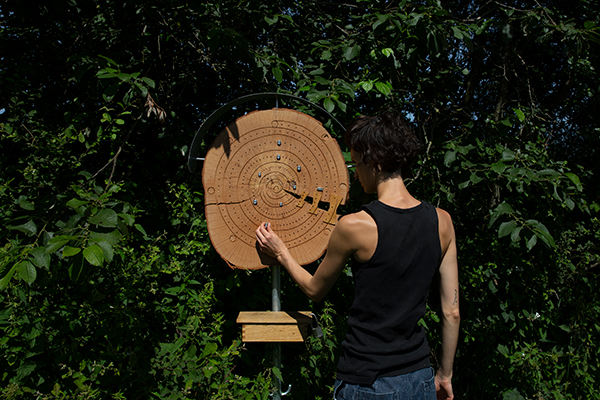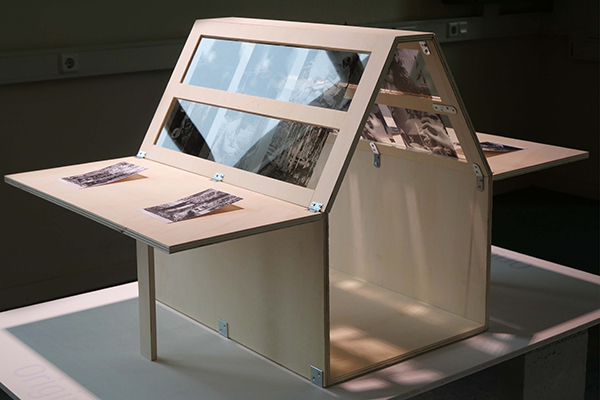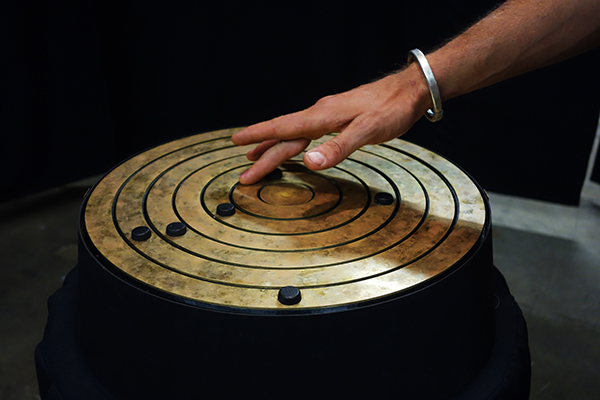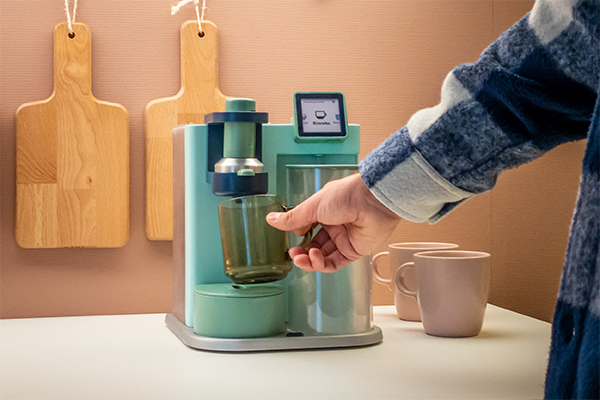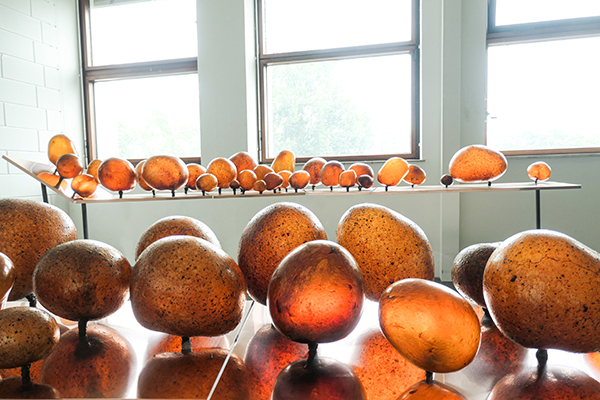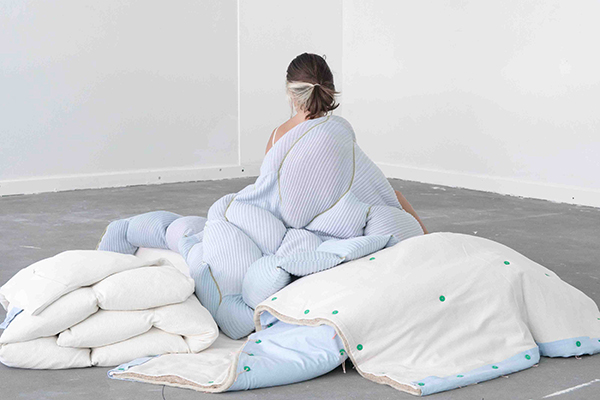KAZERNE DESIGN AWARD 2023
The nominees for the Kazerne Design Award 2023, from left to right: Pepe Triginer Valenti, Jelle Seegers, Héloïse Floc’h, Leopold Inkapööl, Marte Mei van Haaster, Thomas Mair, Ori Orisun Merhav, Zoa Lu Rosenkranz. Photo Ruud Balk
TOMORROW WILL BE SHAPED BY TODAY’S STUDENTS
Radically different tools are needed for a truly sustainable society. To produce these, Jelle Seegers developed a huge magnifying glass that melts metal to make tools. With this, he won the Kazerne Design Award on May 9. His graduation project Solar Metal Smelter was rewarded by the jury with eternal fame, an exhibition, introduction to a new network plus 5,000 euros. Courtesy of Rotary Club Eindhoven-Soeterbeek. Seegers was one of 9 nominees for the incentive award, all of whom recently graduated from Design Academy Eindhoven.
Seegers immediately donated part of his prize to the other eight nominees. Kazerne Foundation then decided to divide all contributions to be received in May 2023 among them via www.kazerne.com’s donation page. Geurts: “This year, too, it was exciting until the last moment. It is impossible to make a comparison between the different works because of the diversity in concept and execution. Hopefully, through this way we can give all the nominees a shot in the arm’.
Watch the recording of the Award Show here.
Jury
Kiki van Eijk is one of the most accomplished names of Dutch Design. Her world is whimsical and colorful, lyrical and personal, yet refined by skillful craftsmanship.
In her design studio, Anne Ligtenberg explicitly chooses to work with subjects that contribute to our personal and/or social well-being. She is able to successfully translate and visualise complex issues into accessible designs.
Annemoon Geurts is the founder and creative director of the renowned design hub Kazerne where she, together with guest curators like Joseph Grima, Lidewij Edelkoort and Ilse Crawford, shows the meaning of design for the world of tomorrow.
Jan Hoorntje, former CEO of Polaroid, has a strong and successful background in brand building and a deep understanding of the power of design to transform businesses.
Winner
Jelle Seegers – Solar Metal Smelter
The Solar Metal Smelter is a seemingly simple installation: a huge magnifying glass carefully directs all sunlight to one point in an insulated crucible that heats to almost 1000 degrees Celsius. In this extreme heat aluminum and zinc waste is molten, and then poured into a mold where it solidifies into a form that lasts for generations.
When Jelle Seegers set himself to design and work in a sustainable manner, he experiences that often the tools to work sustainably were not at hand. Therefore, he started designing those tools himself. He now designs the tools that enable other designers and makers to work sustainably.
Jelle Seegers radically designs and makes sustainable tools and working methods. For the next five years he has set himself to develop a solar, wind and human-powered factory for manufacturing solar-wind and human-powered tools. When the sun shines it is his time to melt and pour metal. When the wind blows, there is drilling, twisting and sawing. At other times, hand tools are used and it is time for his ‘days off’.
Nominees
Yassine Ben Abdallah | The bittersweet memory of the plantation
The culturing of sugarcane is pivotal for the history of the island La Réunion, a former French colony. However, all the objects left of this history belonged to the white dominators. As their artefacts were lost, the stories of enslaved and forced labourers often remain untold.
Yassine Ben Abdallah researched the culture, stories and artefacts of the oppressed laborers at the island’s sugar plantations. He designed these dripping sugar machetes to oppose the dominators artefacts, and raise the question: whose heritage and history are allowed to be preserved, narrated and immortalized?
Yassine Ben Abdallah is an artist and designer based between La Réunion and The Netherlands. His research-based practice focuses on issues of heritage, cultural identity, and belonging. More specifically, he addresses the historical and contemporary afterlife of the colonial wounds in postcolonial societies.
Marte Mei van Haaster | Land-Ally
Land-Ally turned a one-acre agricultural field just outside Eindhoven into a participatory nature reserve. Specially designed tools invite people, animals and nature to equally engage in a symbiotic collaboration.
The objects sit on the land as sculptures that are activated in care workshops, in which humans, animals and plants must collaborate. Land-Ally aims to form an interspecies community based on wellbeing and allyship.
Marte Mei is a social designer with a passion for ecological justice and equity. Marte uses her artistic background in color and form to inspire people’s imagination. Through site-specific installations, land-based projects and spatial design, Marte reimagines the role of humans within the ecosystem.
Héloïse Floc’h | Duty of Remembrance
The historical greenhouse Jardin d’Agronomie Tropicale in Paris houses thousands of plants. These rare species were once taken from faraway places, analyzed, and then mass grown in French colonies. For the last decades, however, the greenhouse building has been left to degrade, and the knowledge about these rare colonial species is slowly forgotten.
Héloïse Floc’h investigated these living witnesses and the greenhouse’ past. She found that many of the non-native species have been gradually integrated in our everyday lives, yet their stories of origin, transportation, and cultivation are rarely told. With a curated exhibition of these plants, she helps to educate about the difficult pasts at the root of our current culture.
Héloïse Floc’h is a French researcher and designer based in Amsterdam. Through site visits and archival research, she unravels stories of subjects that were previously overlooked. Through careful curation and poetic presentation, she is able to bring complex stories to life, empathically and relatable.
Leopold Inkapööl | Omniphonium
The human hearing is exceptionally good at locating sounds around us. However, most audio setups have only one or two sources. What if playing an electronic musical instrument could also be a spatial experience?
The Omniphonium is an audio controller that allows the user to move sounds around the space. The instrument has seven touch-sensitive brass rings, each of which connects to a unique sound. By touching and turning the rings intuitively, the user playfully creates their own 360° sound compositions.
With a background in music, artist and designer Leopold Inkapoöl creates interactive installations that open up the experience of sound making and listening. He especially enjoys working in public spaces, where his projects can be accessed and appreciated by all. In addition to his independent work, he is also part of a collective that designs creative public playgrounds for children.
Thomas Mair | Kara
How to repair a broken coffee machine? Our everyday appliances seem to have become so complex that we have no idea how they function from the inside. As a result, when items break, we tend to discard the complete machine. And unfortunately, only very few of those are recycled.
Coffee machine Kara breaks with this wasteful habit. Constructed from large, magnetic parts and with its toylike design, Kara invited the user to open the machine intuitively. When broken, the parts can be easily replaced. With Kara, Thomas proposes a new design standard for all appliances, for which repairing is the only logical choice.
Originally from South Tyrol and now based in the Netherlands, Thomas Mair aims to promote sustainable living through seemingly simple solutions for complex issues. By taking a grounded, practical approach, his designs inspire action towards more sustainable human behaviors.
Ori Orisun Merhav | Made by Insects
The natural polymer lac is commonly known for its use as a coating material (shellac). Its production process by lice has allowed for local economies to thrive. However, with the rise of chemical coatings, the demand for the natural material has been decreasing.
Ori Orisum Merhav traveled to Thailand to investigate ways to reinvigorate the material’s industries. Inspired by the insects themselves, Ori started experimenting with various treatments of the material. Curious craftsmen joined in her research. Their shared discoveries led to a living archive of shapes and textures that reveal a new aesthetic in the material. Ori presents the new techniques in the form of an open- source library, for other explorers to build on.
Ori Orisun Merhav an artistic researcher and designer with passion for materials and the stories they carry. Through her practice she observes ecological points of view, aiming to bring awareness to global issues and create a more ‘bio-inclusive’ future for our planet. Her process is collaborative, often bringing together people from different backgrounds and minds.
Zoa Lu Rosenkranz | Unfolding the blanket
Half of our lives we spend in or around our beds, and thus: close to our blankets. Yet, we tend to give them little attention – to how they are made, and how we are using them. Consequently, they are easily discarded.
Unfolding the Blanket is a collection of redesigned duvets that reveal the inside anatomy. Through the visible and tangible use of materials and techniques, such as natural downs and zero-waste knitting, the blankets invite long-term use with attention and care for its lifecycle.
Textile designer Zoa Lu Rosenkranz is concerned with the construction of everyday objects, the materials used to make them, and their impact on the environment. She lays bare the processes that have become distant due to industrialisation, while she explores the potential of local production to change the lifecycle of objects and revalue materials. Zoa’s approach to design involves documenting the journey of a material, exploring its potential through hands-on experimentation, and bridging the gap between the way materials are used and their appreciation in our daily lives.
Pepe Triginer Valenti | El Mar Installation
When looking at the sea, especially the horizon, there is a magical phenomenon: an infinite number of sparkling reflections created by the sunlight hit the surface of the water. The movement of the waves makes an aesthetic harmony of continuous light reflections – a mesmerizing moment for the human eye.
El Mar mimics the water through its static shapes and its fluctuating light in the surrounding space, creating an immersive moment in an unexpected environment. The mirrors are made from stainless steel and coated with chrome. Every piece is carefully crafted into its organic shape, using heat.
Pepe Valenti works within the fields of product and installation design with a strong focus on materiality. His works result from hands-on and intuitive experimentation with his materials: thinking through making. While Pepe’s inspiration stems from raw and untouched matters, his treatment is very polished and refined – an interesting contrast between the source and outcome.

